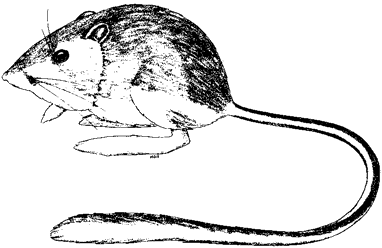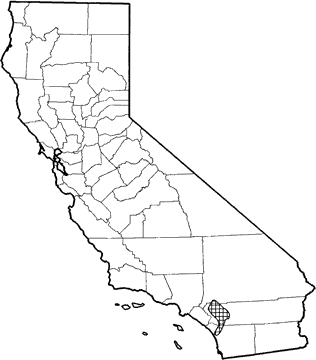
Stephens' Kangaroo Rat
Distribution, Abundance, and Seasonality
Known from 16 localities in and around San Jacinto Valley from Riverside, Riverside Co., south to vicinity of Vista, San Diego Co. (Thomas 1975). The number of verified localities has declined over the past half century, due mainly to urbanization and cultivation of suitable habitat. Occurs primarily in annual and perennial grassland habitats, but may occur in coastal scrub or sagebrush with sparse canopy cover, or in disturbed areas. Preferred perennials are buckwheat and chamise; preferred annuals are brome grass and filaree.

Range Map
Specific Habitat Requirements
Feeding: Granivorous. Known to eat filaree and brome grass and other annual grasses and forbs (Thomas 1975).
Cover: Sparse perennial plant cover is preferred (Thomas 1975). Burrows may be excavated in firm soil that is "neither extremely hard nor sandy" (Lackey 1967a), but Thomas (1975) found most individuals occupying abandoned pocket gopher burrows.
Reproduction: Young are born in nest burrow with bedding of dried plants such as mustard (Thomas 1975). Nest building was observed in captive, pregnant individuals (Lackey 1967a).
Water: No data found. Probably obtains water from food.
Pattern: Sparse perennial vegetation with firm soil, "neither hard nor sandy" (Lackey 1967a).
Species Life History
Activity Patterns: Nocturnal. Active year-round (Bleich 1977).
Seasonal Movements / Migration: None.
Home Range: Home range varied from 0.06 ha (0.14 ac) to 0.10 ha (0.24 ac). Density varied from 40/ha (16.4/ac) to 58/ha (23.7/ac). Home range size appears to be a function of population density (Thomas 1975).
Territory: No data found. Aggressively solitary. Territory size probably somewhat less than home range.
Reproduction: Little information available. Probably breeds from April into June. Litter size averages 2.5 (Lackey 1967a).
Niche: Stephens' kangaroo rat is a moderate-sized granivore. Main competitors for food resources probably are cricetid rodents, although there also is some niche overlap with D. agilis. D. agilis, however, tends to occur in areas of moderate to dense chaparral cover. Predators include snakes, owls, and predatory mammals.
Comments: The Stephens' kangaroo rat is a Threatened and Endangered species. Habitat loss, through urbanization and cultivation, is responsible for the reduction in range over the last half century. The population studied by Thomas (1975) exists in healthy abundance, but may change rapidly in the face of development.
Sources & References
California Department of Fish and Game, 1999.
California's Wildlife, Sacramento, CA.
Written by: P. Brylski, reviewed by: H. Shellhammer, edited by: R. Duke
Bleich, V. C. 1977. Dipodomys stephensi. Mammal. Species No. 73. 3pp. Grinnell, J. 1922. A geographical study of the kangaroo rats of California. Univ. Calif. Publ. Zool. 24:1-124. Lackey, J. A. 1967a. Growth and devlopement of Dipodomys stephensi. J. Mammal. 48:624-632. Lackey, J. A. 1967b. Biosystematics of heermanni group kangaroo rats in southern California. Trans. San Diego Soc. Nat. Hist. 14:313-344. Thomas, J. R., Jr. 1973. Stephens' kangaroo rat survey, 1972-1973. Calif. Dept. Fish and Game, Spec. Wildl. Invest., Sacramento. Final Rep. Job II-5.6. 10pp. Thomas, J. R., Jr. 1975. Distribution, population densities, and home range requirements of the Stephens' kangaroo rat (Dipodomys stephensi). M.S. Thesis, California State Polytechnic Univ., Ponoma. 64pp.
California Animal Facts | California's Wildlife